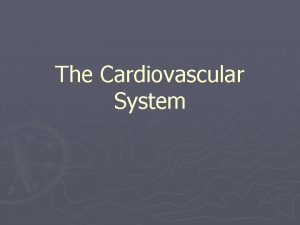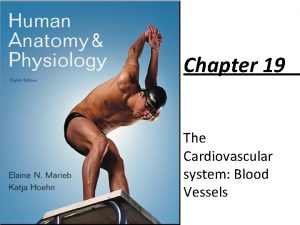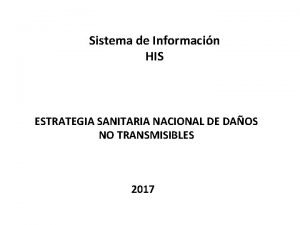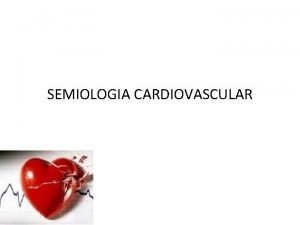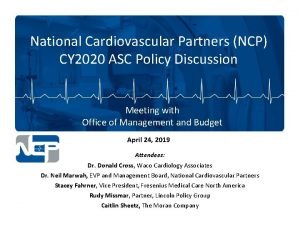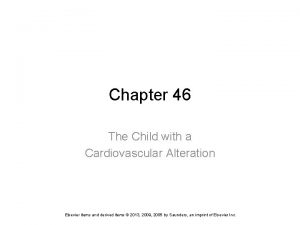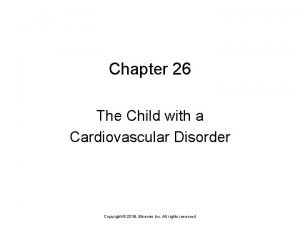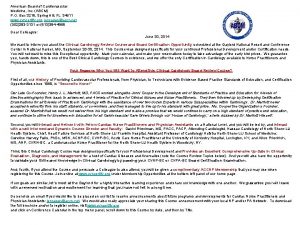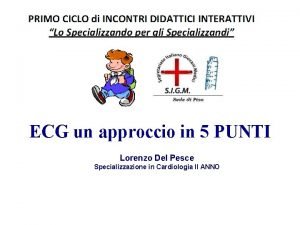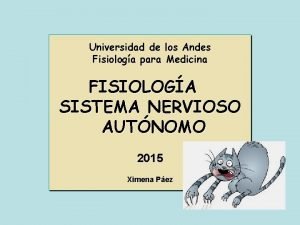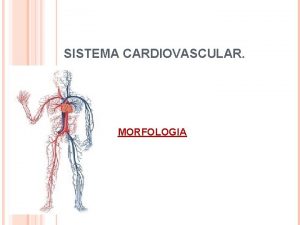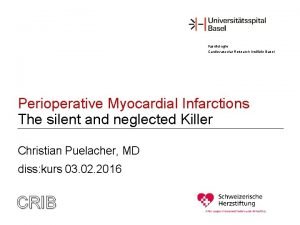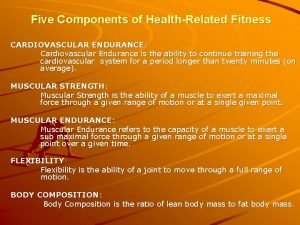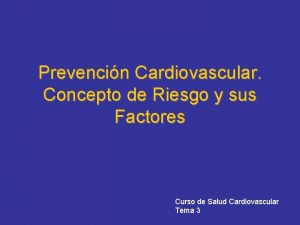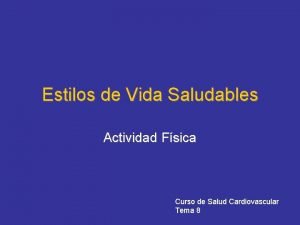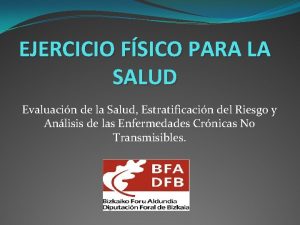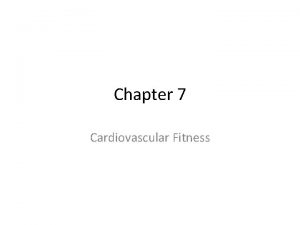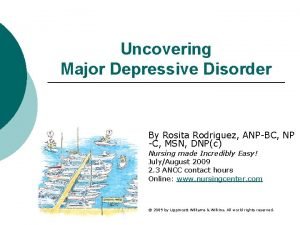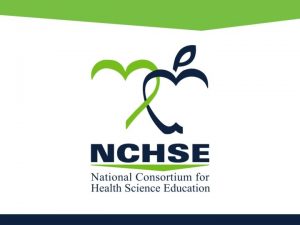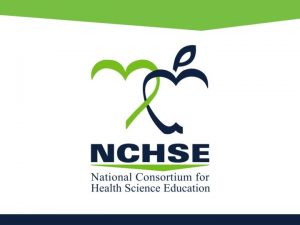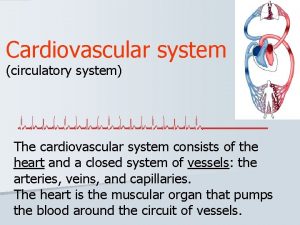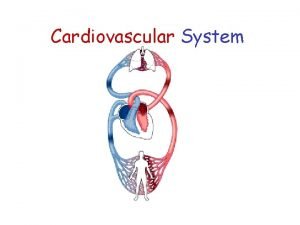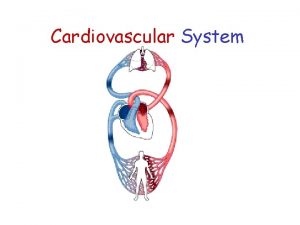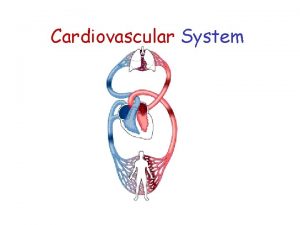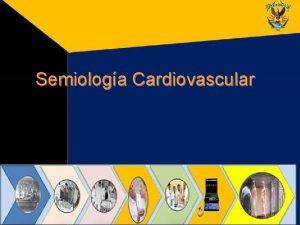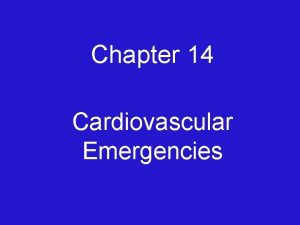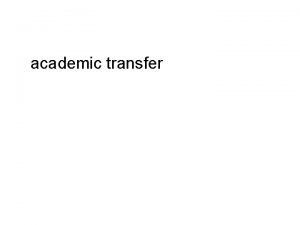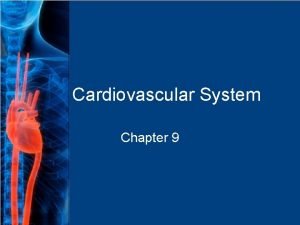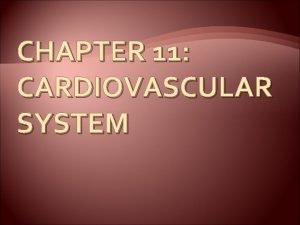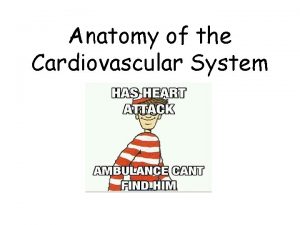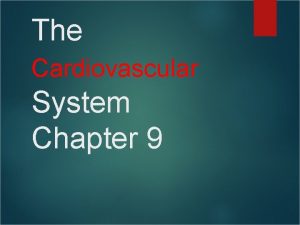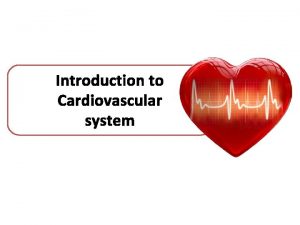The Cardiovascular System Foundation Standard 1 Academic Foundation











































- Slides: 43


The Cardiovascular System • Foundation Standard 1: Academic Foundation Understand human anatomy, physiology, common diseases and disorders, and medical math principles. 1. 13 Analyze basic structures and functions of human body systems • Components Of Blood • Structures And Functions Of Blood Components • Structures And Functions Of The Cardiovascular System • Conduction System Of The Heart • Cardiac Cycle 1. 21 Describe common diseases and disorders of each body system • Etiology • Pathology • Diagnosis • Treatment • Prevention 2

The Cardiovascular System Function- Transportation • 02/CO 2 • Nutrients • Wastes • Hormones • Antibodies • Regulate body temperature 1. 13 Analyze basic structures and functions of human body systems (cardiovascular). d. Cardiovascular (functions of the cardiovascular system) 3

The Cardiovascular System Components • Blood Vessels • Arteries • Capillaries • Veins • Heart 1. 13 Analyze basic structures and functions of human body systems (cardiovascular). d. Cardiovascular (structures of the cardiovascular system) 4

Blood • Liquid tissue • Liquid- Plasma 55% • H 2 O (90%) and proteins • Cells 45% • Red Blood Cells • White Blood Cells • Platelets 1. 13 Analyze basic structures and functions of human body systems (cardiovascular). d. Cardiovascular (components of blood, )c 5

Blood Components Total Blood Volume 6 qt. = 12 pt. 1. 13 Analyze basic structures and functions of human body systems (cardiovascular). d. Cardiovascular (components of blood, structures) 6

Blood • White blood cells (WBC) - Fight infections • Red blood cells (RBC) - Contain hemoglobin Normal - Carry 02 • Platelets – - Also called thrombocytes - Aid in blood clotting 1. 13 Analyze basic structures and functions of human body systems (cardiovascular). d. Cardiovascular (components of blood, structures and functions of blood components)c 7

Blood Normal • Hemoglobin • • Heme = iron Globin = protein Provides oxygen to tissues Returns CO 2 to lungs Gives RBCs their red color 1. 13 Analyze basic structures and functions of human body systems (cardiovascular). d. Cardiovascular (components of blood, structures and functions of blood components)c 8

Blood Abnormal • WBC - abnormal WBC - leukemia • RBC - too few red blood cells - too little hemoglobin ANEMIA • Platelets - hemorrhage, profuse bleeding 1. 13 Analyze basic structures and functions of human body systems (cardiovascular). d. Cardiovascular (components of blood, structures and functions of blood components)c 9

Leukocytes • Granulocytes - granules • Agranulocytes - no granules 1. 13 Analyze basic structures and functions of human body systems (cardiovascular). d. Cardiovascular (components of blood, structures and functions of blood components)c 10

Granulocytes(granules) • BASOPHILS - mast cells - Inflammation, allergies • NEUTROPHILS - 1 st phagocytic cell • EOSINOPHILS - Destroy parasites 1. 13 Analyze basic structures and functions of human body systems (cardiovascular). d. Cardiovascular (components of blood, structures and functions of blood components)c 11

Leukocytes Agranulocytes • MONOCYTES – - 2 ND phagocytic cell - Initiate specific immune response • LYMPHOCYTES – - B and T cells - Produce specific immune response 1. 13 Analyze basic structures and functions of human body systems (cardiovascular). d. Cardiovascular (components of blood, structures and functions of blood components)c 12

Blood Types Antigens • Proteins on the cell surface • Stimulate immune response if foreign to the body Antibodies • Fight foreign intruders causing them to form little clumps (agglutinate) • Reaction can be severe, lifethreatening 1. 13 Analyze basic structures and functions of human body systems (cardiovascular). d. Cardiovascular (components of blood, structures and functions of blood components)c 13

Blood Types • Type A (41% of Americans) - Contains A self-antigens; anti-B antibodies • Type B - Contains B self-antigens; anti-A antibodies • Type AB - Contains both A and B self-antigens; - Neither A nor B antibodies • Type O - Contains NO A nor B antigens; - Both A and B antibodies 1. 13 Analyze basic structures and functions of human body systems (cardiovascular). d. Cardiovascular (components of blood, structures and functions of blood components)c 14

Rh Factor 85% white and 88% African-American population in the U. S. have the Rh antigen: • Rh-positive (+) - Have the Rhesus antigen • Rh-negative (-) - Without the antigen 1. 13 Analyze basic structures and functions of human body systems (cardiovascular). d. Cardiovascular (components of blood, structures and functions of blood components)c 15

Blood Recipients and Donors 1. 13 Analyze basic structures and functions of human body systems (cardiovascular). d. Cardiovascular (components of blood, structures and functions of blood components)c 16

Blood Vessels Arteries Capillaries Veins 1. 13 Analyze basic structures and functions of human body systems (cardiovascular). d. Cardiovascular (structures and functions of the cardiovascular system)c 17

Arteries • • Away from the heart Smooth muscle expand/ contract Spurts with each contraction of the heart Fast O 2 red, oxygenated Hidden Aneurysm- weakened artery 1. 13 Analyze basic structures and functions of human body systems (cardiovascular). d. Cardiovascular (structures and functions of the cardiovascular system)c 18

Capillaries • Exchange diffusion (H L) • One cell thick • Single file SLOOOOW • Slow for time to exchange • Connect arteries to veins 1. 13 Analyze basic structures and functions of human body systems (cardiovascular). d. Cardiovascular (structures and functions of the cardiovascular system)c 19

• • • Veins To the heart Valves prevent the back flow of blood Deoxygenates = Little O 2 Dark Red Little smooth muscle Defective valves: - Varicose veins - Hemorrhoids 1. 13 Analyze basic structures and functions of human body systems (cardiovascular). d. Cardiovascular (structures and functions of the cardiovascular system)c 20

HEART • Pump - 2 pumps - Right and left • Size - fist • Weight - 1 lb. 1. 13 Analyze basic structures and functions of human body systems (cardiovascular). d. Cardiovascular structures and functions of the cardiovascular system)c 21

HEART Heartbeats - Normal = 60 -100 beats/minute Abnormal: - Tachycardia > 100 beats/minute - Bradycardia < 60 beats/minute Ejection blood volume - 2 ½ oz. 1. 13 Analyze basic structures and functions of human body systems (cardiovascular). d. Cardiovascular (structures and functions of the cardiovascular system)c 22

Location of the Heart • Thoracic Cavity - (Chest) Ribcage and Diaphragm • Base - Top - Third Rib - Retrosternal • Apex - Pointed Bottom - On diaphragm - 3 In. to left of sternum 1. 13 Analyze basic structures and functions of human body systems (cardiovascular). d. Cardiovascular (structures and functions of the cardiovascular system)c 23

Anatomy of the Heart • Atria (Pleural) - Top chambers • Atrium (Singular) • Coronary sulcus (sunken) • Divides the atria from the ventricles 1. 13 Analyze basic structures and functions of human body systems (cardiovascular). d. Cardiovascular (structures and functions of the cardiovascular system)c 24

Anatomy of the Heart Ventricles - Bottom chambers • Left - Pumps blood to the body - Thicker walls • Right - Pumps blood to the lungs • Interventricular sulcus - Separates right and left ventricles 1. 13 Analyze basic structures and functions of human body systems (cardiovascular). d. Cardiovascular (structures and functions of the cardiovascular system)c 25

External Anatomy of the Heart Coronary Arteries • Heart arteries • Supply O 2 and nutrients to heart muscles Coronary Sulcus Interventricular Sulcus 1. 13 Analyze basic structures and functions of human body systems (cardiovascular). d. Cardiovascular (structures and functions of the cardiovascular system)c 26

Internal Anatomy of the Heart pericardium myocardium endocardium 1. 13 Analyze basic structures and functions of human body systems (cardiovascular). d. Cardiovascular (structures and functions of the cardiovascular system)c 27

Blood Flow VAVA • • Vein Atrium Ventricle Artery 1. 13 Analyze basic structures and functions of human body systems (cardiovascular). d. Cardiovascular (structures and functions of the cardiovascular system)c 28

Blood Flow - Right VAVA • Vena Cava • Carries blood to the heart • Superior • From the head • Inferior • From the rest of the body 1. 13 Analyze basic structures and functions of human body systems (cardiovascular). d. Cardiovascular (structures and functions of the cardiovascular system)c 29

Blood Flow - Right VAVA • Right Atrium - Right AV valve = Tricuspid valve = lub • Right Ventricle - Pulmonary semilunar valve = dub • Pulmonary Arteries - carry deoxygenated blood to the lungs Lungs where deoxygenated 1. 13 Analyze basic structures and functions of human body systems (cardiovascular). d. Cardiovascular (structures and functions of the cardiovascular system)c 30

Blood Flow – Left VAVA • Pulmonary Vein - Oxygenated - carries blood to the left atrium • Left Atrium - Left A-V VALVE = Bicuspid = Mitral Valve = lub • Left Ventricle - pumps blood to aorta - Aortic semilunar valve = dub • Aorta - carries blood to the body 1. 13 Analyze basic structures and functions of human body systems (cardiovascular d. Cardiovascular (, structures and functions of the cardiovascular system, ) 31

Heart’s Conducting System • Heart’s Conducting System - Electricity • SA NODE- (sino-atria node) - Natural pacemaker , starts the heart beating - Impulses travel from the top of the atrium to the bottom - Atrium contracts from the top to the bottom forcing blood into the ventricle - P Wave 32

Cardiac Cycle 1. 13 Analyze basic structures and functions of human body systems (cardiovascular) d. Cardiovascular (conduction system of the heart, cardiac cycle) 33

Heart’s Conducting System • AV NODE (Atrium-Ventricular node) - • BUNDLE OF HIS - • Conducts impulses from the AV node to the bottom of the ventricle without causing contraction PURKINJE FIBERS - • Collect impulses generated from the SA node allows the atrium to contract before the ventricle Impulses travel from the bottom to the top of the ventricle Contraction of the Ventricle from the Bottom to the Top of Ventricle Out Through the Arteries - QRS wave T wave- ventricles relax 1. 13 Analyze basic structures and functions of human body systems (cardiovascular) d. Cardiovascular (conduction system of the heart, cardiac cycle) 34

Heart’s Conducting System 35

EKG Atrial Contraction Ventricular Contraction LUB DUB No Electrical Activity, CPR Ventricular Fibrillation AED 36

Diseases and Disorders Arteriosclerosis Atherosclerosis Angina Pectoris Myocardial Infarction Hypertension Cerebrovascular Accident 1. 21 Describe common diseases and disorders of each body system (heart disease). a. Etiology b. Pathology c. Diagnosis d. Treatment e. Prevention 37

Coronary Arteries • Arteriosclerosis - Hardening of the arteries leading to loss of elasticity - Increases with aging - Prevention: § Exercise Delays 1. 21 Describe common diseases and disorders of each body system (heart disease). a. Etiology b. Pathology c. Diagnosis d. Treatment e. Prevention 38

Coronary Arteries • Atherosclerosis • Fatty deposits (usually plaque) deposited on the walls of the coronary arteries • Usually enhanced by diets high in saturated fats and cholesterol 1. 21 Describe common diseases and disorders of each body system (heart disease). a. Etiology b. Pathology c. Diagnosis d. Treatment e. Prevention 39

Angina Pectoris • Chest Pain • Caused by Coronary Artery Disease • Ischemia - Occurs during exertion and/or stress Treatment: - Nitroglycerin (vasodilator) - Angioplasty - Calcium - channel blockers - By-pass surgery 1. 21 Describe common diseases and disorders of each body system (heart disease). a. Etiology b. Pathology c. Diagnosis d. Treatment e. Prevention 40

Myocardial Infarction (M. I. ) Heart Attack • Heart Muscle Cell Death • A Condition Caused by Partial or Complete Occlusion of One or More of the Coronary Arteries • Treatment: - Angioplasty By-pass surgery 1. 21 Describe common diseases and disorders of each body system (heart disease). a. Etiology b. Pathology c. Diagnosis d. Treatment e. Prevention 41

Hypertension • High blood pressure - >140/90 ü Top Number = Systole = heart is contracting Ø ü 1 st heart sound (number recorded when taking blood pressure) Bottom number = diastole = ventricles are relaxing Ø last heart sound (number recorded when taking blood pressure) • Treatment - Reduce salt intake - ACE inhibitors - Calcium channel blockers 1. 21 Describe common diseases and disorders of each body system (heart disease). a. Etiology b. Pathology c. Diagnosis d. Treatment e. Prevention 42

Cerebrovascular Accident (CVA) Stroke “Brain Attack” • Brain cells deprived of oxygen due to hemorrhage or ischemia (blood clot) Causes: • High blood pressure • Cigarette smoking • Atrial fibrillation • Physical inactivity Treatment: • Anticoagulants/Anti-platelets • Anti-hypertensives • TPA for ischemic to dissolve the clot 1. 21 Describe common diseases and disorders of each body system (heart disease). a. Etiology b. Pathology c. Diagnosis d. Treatment e. Prevention 43
 Composition of urine
Composition of urine Chapter 19 the circulatory or cardiovascular system
Chapter 19 the circulatory or cardiovascular system What makes up the cardiovascular system
What makes up the cardiovascular system Rat cardiovascular system simulation
Rat cardiovascular system simulation Its tubular dude
Its tubular dude Cardiovascular system crash course
Cardiovascular system crash course Cengage chapter 5
Cengage chapter 5 Figure 11-8 arteries
Figure 11-8 arteries Chapter 11 the cardiovascular system figure 11-3
Chapter 11 the cardiovascular system figure 11-3 Lesson 11 cardiovascular system
Lesson 11 cardiovascular system Lesson 11 cardiovascular system
Lesson 11 cardiovascular system Cardiorespiratory system includes
Cardiorespiratory system includes Hypertensive atherosclerotic cardiovascular disease
Hypertensive atherosclerotic cardiovascular disease Introduction of heart
Introduction of heart Ptca
Ptca Anatomy and physiology unit 7 cardiovascular system
Anatomy and physiology unit 7 cardiovascular system Cardiovascular system diseases and disorders chapter 8
Cardiovascular system diseases and disorders chapter 8 Chapter 13 cardiovascular system
Chapter 13 cardiovascular system Chapter 11 the cardiovascular system figure 11-2
Chapter 11 the cardiovascular system figure 11-2 The cardiovascular system includes the
The cardiovascular system includes the Major arteries
Major arteries Venule
Venule Pad foundation section
Pad foundation section Riesgo cardiovascular por perimetro abdominal
Riesgo cardiovascular por perimetro abdominal Maniobra de pachon
Maniobra de pachon Rias hipertension arterial
Rias hipertension arterial Fresenius national cardiovascular partners
Fresenius national cardiovascular partners When does stroke volume increase
When does stroke volume increase Chapter 46 the child with a cardiovascular alteration
Chapter 46 the child with a cardiovascular alteration Chapter 26 the child with a cardiovascular disorder
Chapter 26 the child with a cardiovascular disorder Wolters kluwer
Wolters kluwer American board of cardiovascular medicine
American board of cardiovascular medicine Battiti ectopici ventricolari forum
Battiti ectopici ventricolari forum Centro cardiovascular
Centro cardiovascular Sistema digestivo
Sistema digestivo Isgemiese hartsiekte
Isgemiese hartsiekte Fitness components
Fitness components Salud cardiovascular
Salud cardiovascular Cardiovascular endurance mapeh
Cardiovascular endurance mapeh Salud cardiovascular
Salud cardiovascular Fsico
Fsico Chapter 7 cardiovascular fitness
Chapter 7 cardiovascular fitness Chapter 17 cardiovascular emergencies
Chapter 17 cardiovascular emergencies Rosita rodriguez
Rosita rodriguez



















